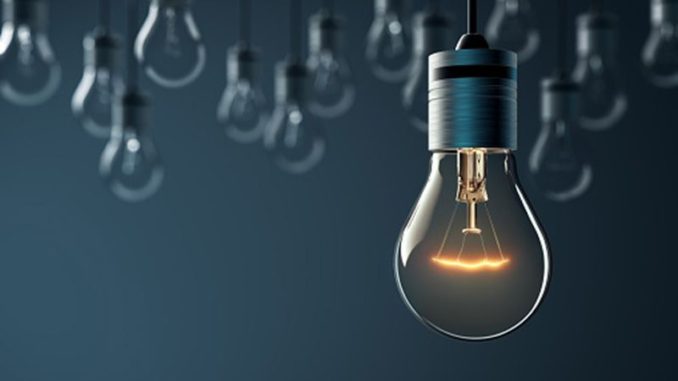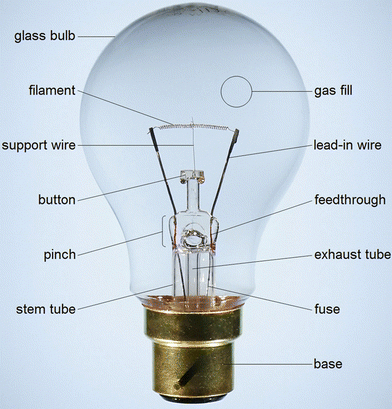
- When electric current flows through the conductor of high resistance, first it becomes very hot and then glows to emit light. This is called the lighting effect of electric current.
- Electric bulbs such as filament lamp (also called incandescent lamp) and fluorescent lamp are the important application of lighting effect of electric current.
1. Incandescent lamp or Filament lamp and its working mechanism:
-
- The filament lamp gives light when electric current flows through it.
- It has a thin, long coiled filament of Tungsten which is supported by copper or nickel wire.
- The filament is enclosed in a glass bulb, which contains very little nitrogen gas or inert gas like Argon, Neon.
- The temperature of the filament is very high, about 29000C when it glows. At this high temperature, the filament becomes white hot and emits out more energy largely in the form of heat and light.
- To withstand this high temperature, Tungsten is used as the filament, which has high resistance and a very high melting point of 34000C.
*Why do we fill a filament lamp with Nitrogen or inert gases?
- At high temperature, the oxygen present in air would react with Tungsten of the filament and form its oxide. Thus, air is removed from the bulb.
- In vacuum, Tungsten evaporates quickly. So, the bulb is filled with nitrogen or inert gases like Neon or Argon. The pressure of the gas reduces the evaporation of the heated filament.
Disadvantages of filament lamp:
- Filament lamp converts only about 10% of electrical energy to light and remaining 90% to heat. Thus, it consumes more electricity and gives less light.
- It lasts for 1000 hours only.
2. Fluorescent lamp and its working mechanism:
-
- The working mechanism of fluorescent lamp is different from that of filament lamp.
- It consists of a long glass tube with two electrodes at two ends. It further consists of a choke (ballast) and a fluorescent starter (glow starter).
- A choke provides high voltage to the circuit. Without the ballast or choke, the current through the tube would exceed the maximum limits causing the tube to burn out.
- The inner wall is coated with fluorescent powder like Zinc and Cadmium silicates. This fluorescent powder glows when it absorbs ultraviolet radiation.
- The inside of the tube is filled with mercury vapor at low pressure and the electrodes are provided with two external leads for connecting to the power supply.

- Fluorescent starters or glow starters are used to help fluorescent tubes and lamps ignite in the initial starting stage of their operation.
- In simple words, fluorescent starters are a timed switch. The switch opens and closes until the fluorescent tube ‘strikes’ and lights-up. If the fluorescent tube does not light, the switch repeats its open/close cycle and the fluorescent tubes attempts to ignite again.
- When electric current flows, one electrode (cathode) is heated and emits electrons. These electrons move towards the other electrode (anode) with high velocity.
- These moving electrons collide with the mercury atoms (from Hg vapor) and produce invisible UV radiation.
- The fluorescent powder then absorbs these invisible UV radiation and turns into visible light.
Advantages of fluorescent lamp over filament lamp:
- It converts 30% of electrical energy into light and 70% into heat. Thus, its efficiency is three times more than that of the filament lamp.
- It lasts for 3000 hours.
